A lot of snakes eat rodents. After all, mice are just about the right size for most snakes to wrap their mouths around to swallow whole. But some snakes rarely, if ever, eat rodents. In some cases, the snake is too small to consume rodents. In other cases, certain snakes live in places where rodents are not available. Here are 12 snakes that don’t eat mice, rats, or any other type of rodent.
1. Sea Snakes
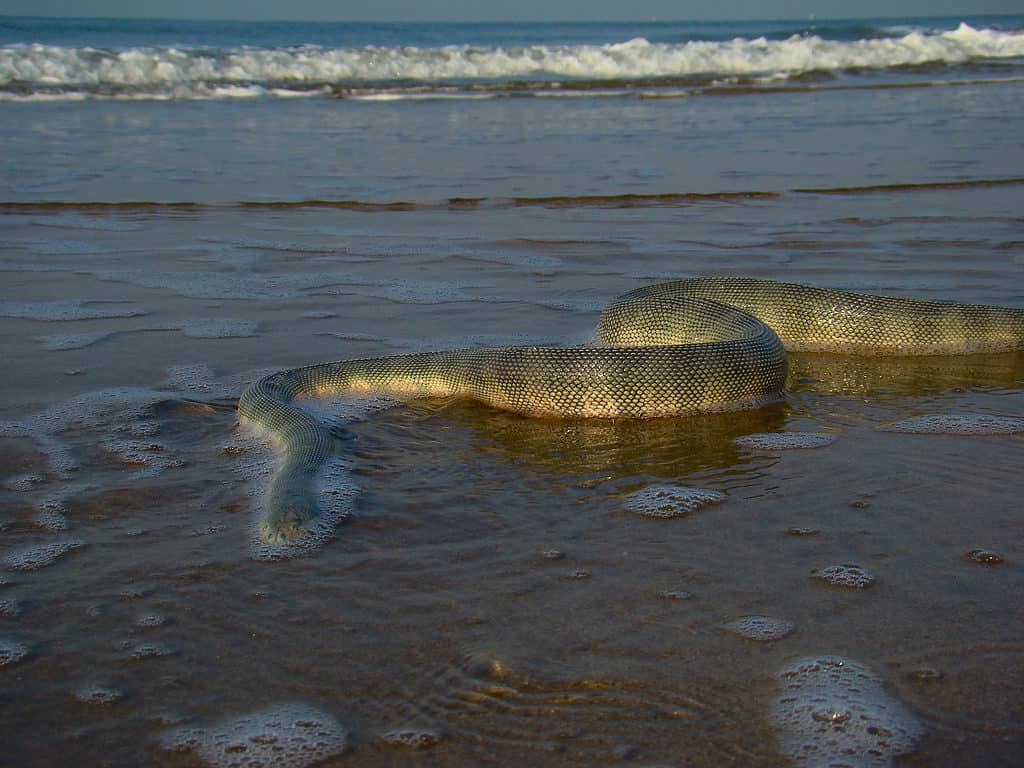
Though a sea snake may love a rodent for a meal, rodents simply don’t live in the ocean.
©IHX/Shutterstock.com
As sea snakes rarely or never leave the sea, they are simply not going to have rodents on their menu. These snakes, which are close relatives of cobras, are highly venomous but rarely bite humans. Found in the warm oceans off the coasts of Africa, Asia, Australia, and Central and South America, these reptiles live a pelagic lifestyle. Most eat fish exclusively and have even been known to steal fish from fishing lines.
2. Egg-Eating Snake

These snakes have developed an amazing way to safely eat large eggs.
©Joe McDonald/Shutterstock.com
As their name suggests, these snakes eat eggs. Most of them live in Africa, though there’s one species in India. The common egg-eating snake is small, only growing to about 2.5 feet in length. Despite its tiny size, it can easily eat a nice-sized chicken egg. How it does this is fascinating. First, the snake flicks its tongue over the egg to make sure it’s not rotten. Then, it braces the egg against a part of its body, stretches its mouth open, and works its mouth around it. This can take as long as 20 minutes.
As the egg moves down the animal’s throat, the snake’s skin stretches until it’s translucent. Finally, the egg finds a place in the reptile’s gullet right beneath its vertebrae. These vertebrae have projections that hold the egg in place. Other projections pierce the egg when the snake arches its neck. Gut valves push the egg’s contents into the snake’s stomach. After this, the snake spits out the broken eggshell.
3. Blindsnake
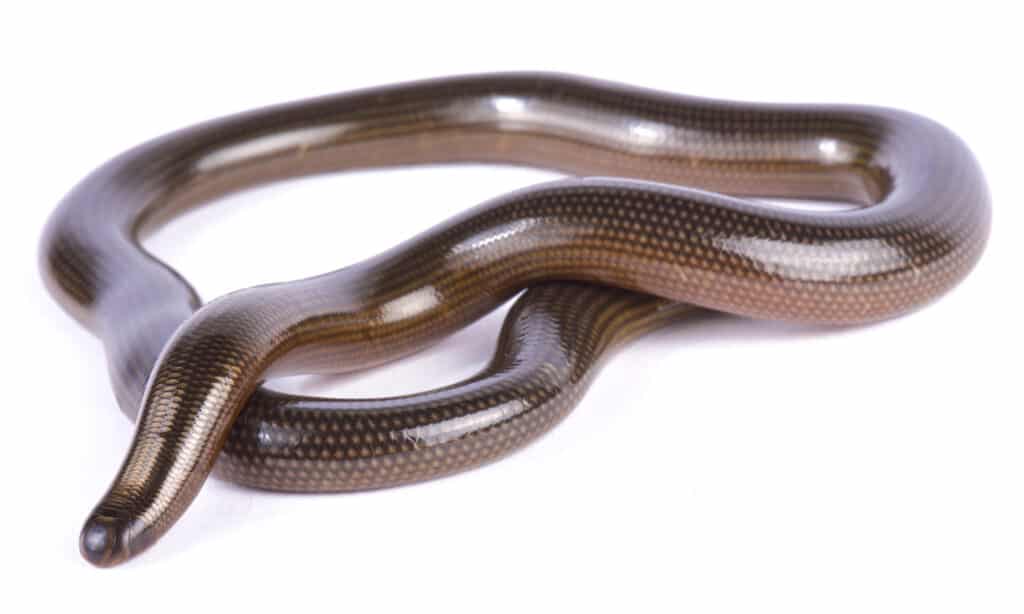
These tiny snakes don’t eat mice or rodents because they’re just too small.
©reptiles4all/Shutterstock.com
Blindsnakes are primitive snakes found in the warmer parts of the world. They don’t eat rodents because they’re simply too small. These snakes rarely grow to 8 inches in length, though one species can grow to 2 feet long. Their eyes are tiny, as are their scales. They often have a spine on the end of their tail that helps them dig. Blindsnakes burrow into the ground and eat insects.
Similar snakes include shieldtails, which eat worms and other soft-bodied invertebrates. Thread snakes are even smaller and thinner than blindsnakes. Many have pelvic bones and even vestigial hind legs that blindsnakes lack. Additionally, thread snakes specialize in termites.
4. Black-Headed Python
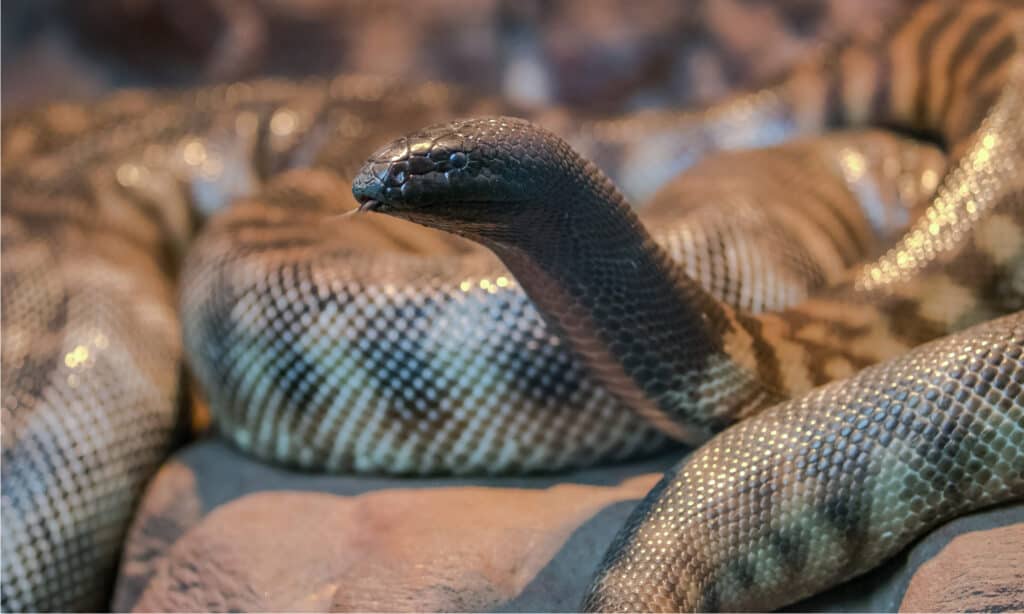
The black-headed python specializes in other reptiles.
©Ken Griffiths/Shutterstock.com
This robust snake is native to Australia. It grows between about 4.9 to 6.6 feet long and weighs about 35.24 pounds. Females are considerably larger than males. The snake’s head is small in proportion to its body, but evolution strengthened the area of its nose and mouth. This makes the snake an excellent digger and allows it to catch and hold on to prey. That prey is mostly other reptiles, including skinks, monitor lizards, and geckos. Black-headed pythons also eat venomous snakes.
5. Slug and Snail-Eating Snake
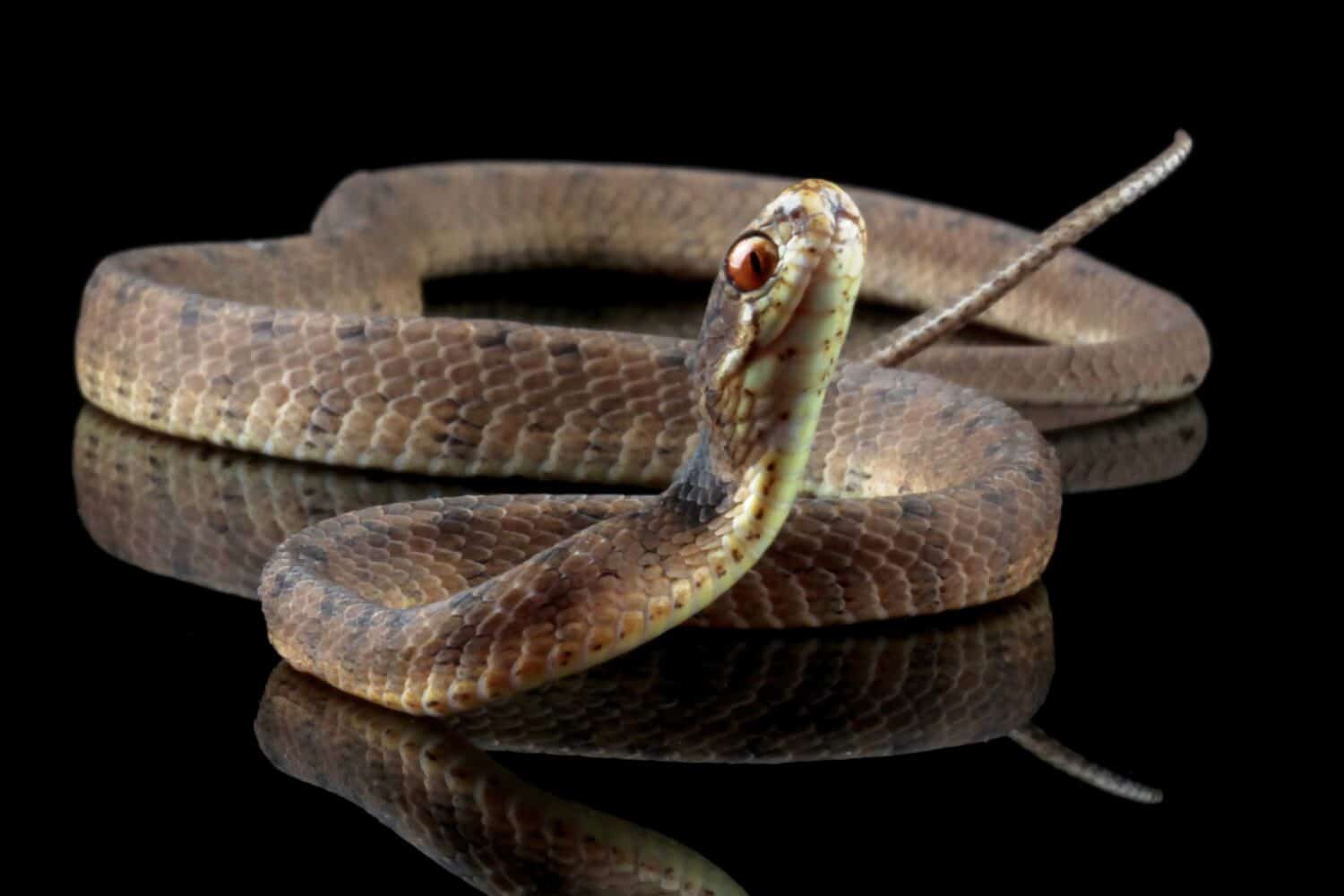
Like the egg-eating snake, snail-eating snakes have evolved an amazing way to eat their favorite prey.
©Agus_Gatam/Shutterstock.com
The common slug-eating snake is found in South America. The sides of its body are compressed, and though it’s nonvenomous, it has large, cat-like eyes with vertical pupils like many venomous snakes. Its head is blunt. These physical characteristics allow the snake, which grows between 24 and 31 inches long, to travel easily through vegetation as it hunts for prey during the night.
You’ll find snail-eating snakes in Central and South America, Southeast Asia, and countries of the Malay Archipelago. These snakes rarely grow over 3 feet in length. Their upper jaw is short and has only a few teeth, but the lower jaw is long and can be manipulated so that it projects past the snake’s nose. The snake bites the snail when it sticks its head out of the shell, and while the upper jaw grips the snake the lower jaw works its way into the shell and eventually twists the rest of the snail out.
Like the slug-eating snake, snail-eating snakes are nocturnal and are notable for their large, bulging eyes.
6. Boomslang
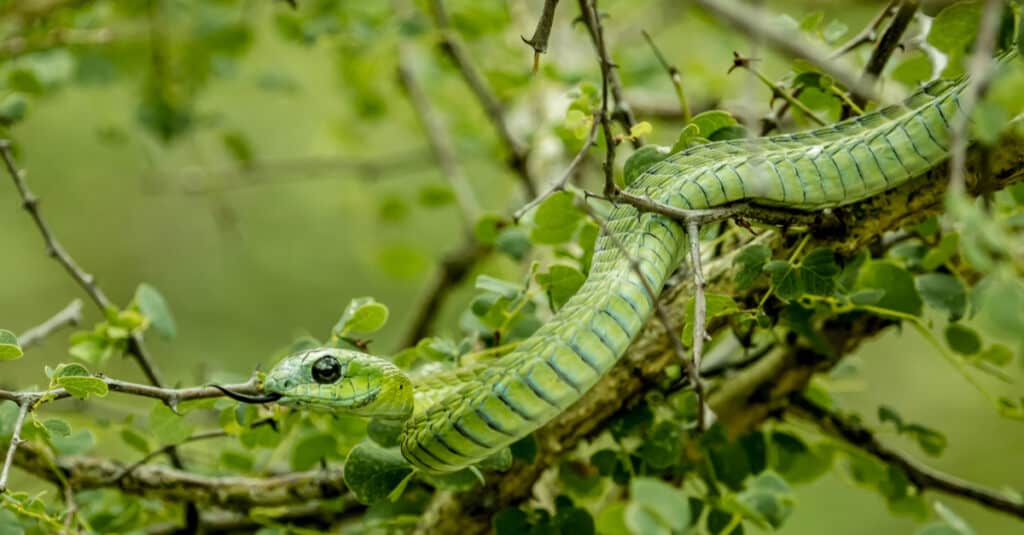
Boomslangs usually don’t eat mice or rodents. Their favorite prey is arboreal lizards.
©OrodO/Shutterstock.com
Found throughout Africa, this snake is about 5 feet long and extremely venomous, with rear fangs that fold back in the mouth when they’re not being used. Boomslangs have huge eyes and are quite slender. Male and female snakes have different colors. Females are greenish brown while males can be a range of colors, including bright, leaf green. This color helps camouflage the snake, which spends much of its time in trees. Boomslangs are ambush predators, and their main diet is made up of tree lizards, including chameleons. Once in a while, they might catch a small mammal, bird, or even another boomslang. Their venom is a hemotoxin, and the prey bleeds to death after being bitten.
7. Water Snake
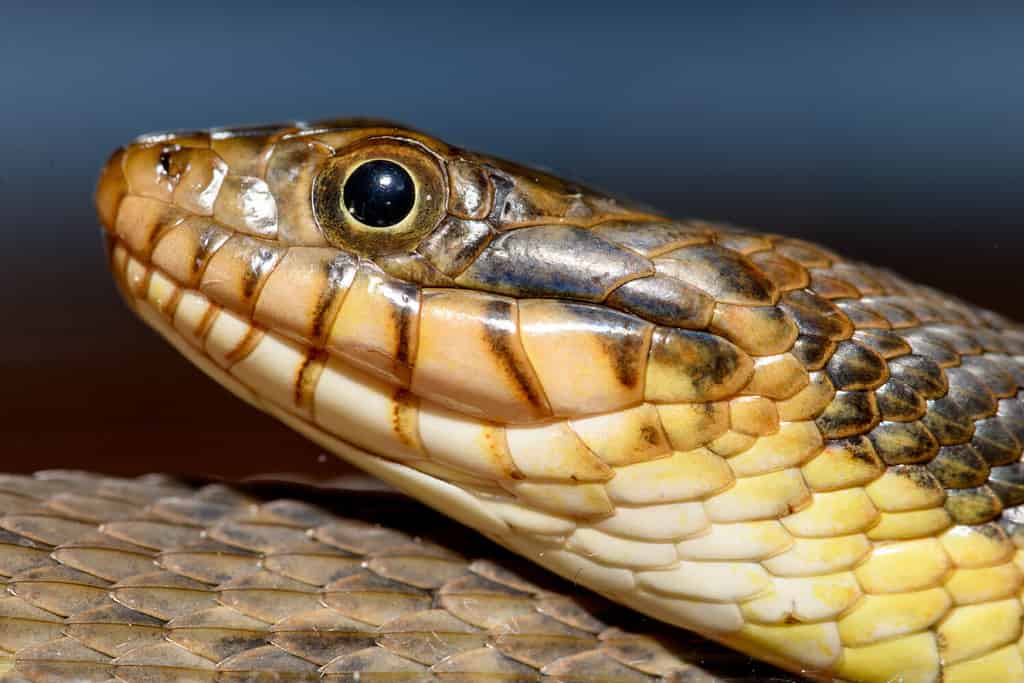
Water snakes prefer fish and amphibians.
©Jeff W. Jarrett/Shutterstock.com
These snakes belong to the Nerodia genus and get their name because they spend much of their time in or close to a body of water. Unlike sea snakes, all of the water snakes are native to North America and non-venomous. They’re robust snakes that can grow to about 4 feet long. They have flat heads and keeled scales on their backs, and their eyes are small and have round pupils. They come in neutral colors such as brown, black, or cream, though many have attractive patterns. The mainstay of their diet is fish and amphibians. However, rodents aren’t completely out of the question. If a mouse comes near the water, they may take that as well.
8. Sri Lanka Green Vine Snake
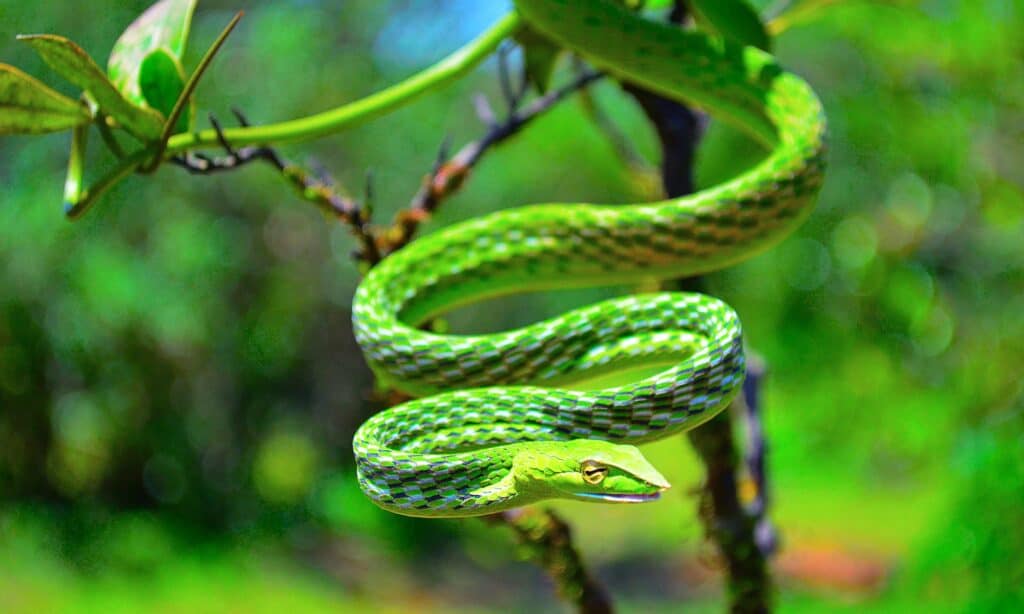
This snake is the only snake known to have horizontal pupils.
©iStock.com/ePhotocorp
The vine snake gets its name because this very slender and usually green snake hides from potential prey by pretending to be a vine in the forests of Sri Lanka. Ahaetulla nasuta is only found in Sri Lanka, and it is the only known snake whose pupils are horizontal. It can grow to 6.25 feet and is also notable for its long and pointed snout. The snake is active during the day and may go to the ground to look for prey. Its main prey are animals called calotes, a type of lizard, and their eggs. After calotes, the vine snake takes geckos, frogs, and slugs.
9. Common Garter Snake

Garter snakes belong to the huge Thamnophis genus
©Matt Jeppson/Shutterstock.com
Garter snakes belong to Thamnophis, the most common genus of snakes found in the United States. They live basically everywhere: farms, forests, wetlands, gardens, and meadows. For many Americans, the garter snake is the archetypal snake. They come in a wealth of colors, but nearly all have round eyes with round pupils, stripes, and keeled scales. Garter snakes used to be considered nonvenomous, but they do have some venom that’s not particularly harmful to people.
If a garter snake is large enough (some can grow to 4.25 feet in length) they’ll take a mouse, but the diet of most garter snakes is overwhelmingly invertebrates. These include earthworms, insects, and aquatic animals such as toads, frogs, tadpoles, salamanders, and crayfish.
10. Golden Lancehead

Golden lanceheads don’t eat mice or rodents because there aren’t anywhere they live.
©Nayeryouakim / Creative Commons – License
This beautiful but deadly snake is found only on Brazil’s Ilha da Queimada Grande, also called Snake Island. This island is closed off for the protection of both the snakes, which are critically endangered, and people who might get bitten.
The golden lancehead gets its name from its pale golden ground color and the shape of its head, which is common in snakes from the Bothrops genus. The snake grows to around 28 inches in length. Because the island has been isolated since the last Ice Age, there are no small rodents, and the snake has evolved to eat birds, lizards, and smaller lanceheads.
11. Eastern Coral Snake

The common coral snake is endemic to the American South.
©Scott Delony/Shutterstock.com
The eastern coral snake, Micrurus fulvius, is only found in the southeastern part of the United States. It’s usually less than 3 feet in length, though there are some who have reached 4 feet. Females are longer than males. The snake is pretty, with red, black, and yellow rings and a black snout, but it’s also venomous. Found in hammocks, scrub oak forests, and flatwoods, this snake dines on birds, insects, frogs, and lizards. It has no problem eating other snakes, including those of its own kind. The common coral snake bites its prey’s head, waits until its venom paralyzes it, then swallows it whole.
12. Peringuey’s Adder

This snake buries itself in the sand and waits for its lizard prey to pass by.
©AZ Outdoor Photography/Shutterstock.com
This small snake, which grows to no more than 13 inches in length, is notable for its flat, wedge-shaped head with keeled scales. Its body is sand or brownish colored with dark and pale spots. The snake’s eyes are on top of the head, which allows it to see when buried in the desert sand. It’s only found in South Angola and Namibia.
A venomous snake, Peringuey’s adder waits beneath the sand for prey, which includes desert lizards and the barking gecko. These reptiles might be lured by the adder’s tail, which it sticks up from the sand. When prey is close, the snake seizes it.
The photo featured at the top of this post is © Rich Carey/Shutterstock.com
Discover the "Monster" Snake 5X Bigger than an Anaconda
Every day A-Z Animals sends out some of the most incredible facts in the world from our free newsletter. Want to discover the 10 most beautiful snakes in the world, a "snake island" where you're never more than 3 feet from danger, or a "monster" snake 5X larger than an anaconda? Then sign up right now and you'll start receiving our daily newsletter absolutely free.
Thank you for reading! Have some feedback for us? Contact the AZ Animals editorial team.






